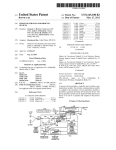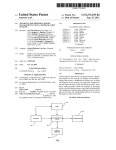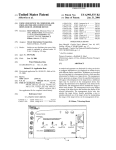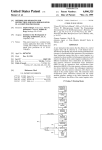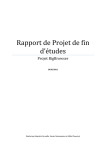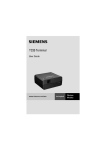Download Integrated personal digital assistant device
Transcript
US007395089B1 (12) Ulllted States Patent (10) Patent N0.: Hawkins et a]. (54) US 7,395,089 B1 (45) Date of Patent: INTEGRATED PERSONAL DIGITAL ASSISTANT DEVICE 4,916,441 A 4,931,783 A (75) Inventors: Jeffrey C Hawkins, Redwood City, CA . - ranclsco’ ’ _ 0 Fr, . 4/ 1990 Gombrich 6/1990 Atkinson 4,972,457 A 11/1990 O’Sullivan ................. .. 379/59 2438}, 1 genker et al' , 1(:US)’.Th0IgaAs gJglggvgatirx’gsrf?t Jul. 1, 2008 i , lang 5,127,041 A 6/1992 O’Sullivan ................. .. 379/59 a‘ an" RE34,034 E 8/1992 Menlo Park’ CA (Us), Wllham B Rees’ 5,189,632 A 2/1993 Paajanen et a1. ..... .. 364/70505 O’Sullivan ................. .. 375/59 Menlo Park, CA (US) (Continued) ( 73A' ) sslgnee :PlIS a m’ nc’ unnyvalCAUS e’ ( ) (*) Notice: FOREIGN PATENT DOCUMENTS Subject to any disclaimer, the term ofthis CA 2187050 patent is extended or adjusted under 35 5/1997 _ U.S.C. 154(1)) by 591 days. (Commued) OTHER PUBLICATIONS (21) App1.No.: 09/976,475 US. Appl. No. 09/768,829, ?led Jan. 25, 2001, Chu et a1. (22) F1led: Oct. 12, 2001 (Continued) Related US. Application Data (60) Provisional application No. 60/297,817, ?led on Jun. Primary ExamineriGeOrge Eng Assistant Examinerisam Bhattachaltya (51) Int_ CL (57) 11, 2001_ 52 ( goszméll/oo ) (58) _‘ ‘ ‘ ’ ’ ' ABSTRACT An integrated device provides functionality of both a PDA and cellular telephone. Features include apoWer button offer Field of Classi?cation Search ............ .. 455/ 556.1, mg Control ofboth the Computing and telephony functions of 455/5562’ 566’ 5753’ 557’ 412'1’ 4122’ the device; a lid that turns the device on and off and controls _ additional telephony functions; a jog rocker that activates the _ (56) 1_ 4 5 5 / 5 5 7_ 4 5 5 / 5 7 5 3 ‘ """ "_' """ "_' (74) Attorney, Agent, or FII’MiFBIIWICk & West LLP 455/413’ 5_50'1’ 575 '4 See apphcanon ?le for Complete Search hlstory' References Cited device and is used to select from a variety of menu options; application buttons that offer direct access to applications stored on the device, and Which can be con?gured to operate U.S. PATENT DOCUMENTS in conjunction With secondary keys to offer added ?mction ality; a keyboard that enables data input into the device; an 3,573,376 A 4,279,021 A 4,415,065 A 4/1971 Bartlett et 211. 7/1981 See et a1. 11/1983 Sandstedt 4,545,023 A 10/1985 MiZZi ....................... .. 364/709 4,587,630 A 4,725,694 A 5/1986 Straton et a1. 2/1988 Auer et a1. 4,799,254 A 1/1989 Dayton et a1. automatic Word completion ?mction that veri?es and corrects a user’s typing in real time; and a simpli?ed keyboard navi gation system that alloWs the navigation of menus using key board shortcuts. 12 Claims, 8 Drawing Sheets US 7,395,089 B1 Page 2 US. PATENT DOCUMENTS 5,227,614 A 7/1993 Danielson et a1. 5,249,218 A 9/1993 5,334,824 A 8/1994 Martinez Sainton ------ -- 375/59 D423,468 s 4/2000 Jenkins 6,049,796 A 6,052,735 A 4/2000 Siitonen et al. 4/2000 Ulrich et 31, 6,058,304 A 5/2000 6,067,451 A 5/2000 Callighan e131. ......... .. 455/422 455/412 5,335,276 A 5,353,334 A 8/1994 Thompson et al. .......... .. 380/21 10/1994 O’Sullivan . 379/59 D432’099 S D432’535 S 10/2000 10/2000 D14/100 D14/345 5,367,563 A 13354478 5 11/1994 V1995 13431016 S 6,134,453 A 10/2000 10/2000 __ D14/345 Sainton e131. ............ .. 455/553 Sainton .... .. 379/98 Miyahara ----------------- -- 1314/100 5379057 A V1995 Clough etal- 6,141,540 A 10/2000 Richards et al. ............. .. 455/90 5,392,447 A 2/1995 Schlacket al. 6,160,926 A 12/2000 Dowetal‘ D359,734 S 5,436,960 A 6/1995 Nagele et al. ............ .. D14/138 7/1995 campanailretal ------- -- 379/58 6,169,485 B1 6,188,789 B1 1/2001 2/2001 5438611 A 8/1995 Campanmlretal D439,232 s 3/2001 Ledinghametal. 5,446,759 A 8/1995 6,198,783 B1 3/2001 379/58 Campanmlretal ----- -- 375/267 CamPana’Jr‘et a1‘ _____ __ 340/573 Marianetti, 11 et al. .... .. 382/189 5465401 A 11/1995 Thompson 6,204,848 B1 3/2001 Nowlan 6131. 5,479,472 A 12/1995 RE37,141 E 4/2001 Campanmlretal ------- -- 379/58 . D14/144 Campana,Jr.etal. ..... .. 375/346 O’Sullivan ................ .. 455/557 5485373 A V1996 Davisetal D440,959 s 4/2001 Wolfetal. 5,496,992 A 3/1996 Madam eta1~ 6,219,694 B1 4/2001 LaZaridisetal. .. D14/191 709/206 5,550,715 A 8/1996 Hawkins .................... .. 362/31 D442’156 S 5/2001 Lee _______ __ D14/13g 5,584,054 A 5,594,640 A 12/1996 Tyneski et al. .............. .. 455/89 V1997 CaPPS er 91- D443’865 S D446,199 s 6/2001 8/2001 Kim __ Xu e131. .... .. D14/13g . D14/138 5,625,670 A 4/1997 Campana, Jr. et a1. ....... .. 379/58 6,272,190 B1 g/ZOOI Campana, Jr et al 375/345 5,631,946 A 5/1997 Campana, Jr. et a1. 6,278,442 B1 8/2001 Grif?n et al‘ 345/169 5,640,146 A 6/1997 Campana, Jr. et a1. ..... .. 340/573 6,288,718 B1 9/2001 Laursen et 31‘ 5,640,444 A 6/1997 O’Sullivan ......... .. .. 379/59 6,295,372 B1 9/2001 Hawkins et 31‘ 5,650,769 A 379/58 340/573 6,295,460 B1 D385,875 S 11/1997 Harris et al. 7/1997 Campanmlretal D14/138 6,297,795 B1 10/2001 Kato et a1‘ 9/2001 Nageletal. ............ .. 455/557 D386,497 S 5,694,428 A 11/1997 Huslig et al. ....... .. D14/191 12/1997 Campana, Jr. et a1. ..... .. 375/260 6,307,548 B1 6,310,926 B1 10/2001 10/2001 Flinchem et 31‘ Tore 5,710,798 A 5,714,937 A V1998 Campanmlretal ----- -- 375/347 2/1998 campanailretal ----- -- 340/573 D450,307 s 6,317,592 B1 11/2001 11/2001 Xu e131. .................. .. D14/138 Campana,Jr.etal. ..... .. 455/412 5,717,725 A 5,722,059 A 2/1998 Campana, Jr. et a1. ..... .. 375/347 2/1998 Campana, Jr’ 9491 4550262 6,330,618 B1 12/2001 D454,349 s Hawkins et 31‘ 3/2002 Makidera et a1. ......... .. D14/343 5,722,064 A 2/1998 campanailretal ----- -- 455/351 D455,135 s 4/2002 D393,856 S 5,742,644 A 4/1998 Lee et a1. ................. .. D14/138 4/1998 Campana, Jr. et a1. ..... .. 375/316 6,370,518 B1 6,377,685 B1 4/2002 Payne et 31‘ 4/2002 Krishnan Campanmlretal ----- -- 375/347 Hyun ...................... .. D14/138 5,745,532 A 4/1998 D456,805 s 5/2002 5,751,773 A 5/1998 Campana, Jr. et a1. ..... .. 375/346 6,396,482 B1 5/2002 Grif?n et 31‘ 13395300 S 6/1998 Yamazaki eta1~ -------- -- 1314/138 6,397,078 B1* 5/2002 5,761,621 A 6/1998 6,421,707 B1 7/2002 Miller et al. 5,797,089 A 5,797,098 A 8/1998 Nguyen .................... .. 455/403 8/1998 Schroederetal ~455/453 Ono e131. ................ .. D14/342 Kiin ...................... .. 455/556.2 6,452,588 B2 6,477,482 B1* 9/2002 Grif?n et a1‘ 11/2002 Maupin e131. ............ .. 702/183 12/2002 Grif?n 6131. 5,798,759 A 8/1998 Dahl 6,489,950 B1 5,805,633 A 5,812,117 A 9/1998 Uddenfeldt ............... .. 375/202 9/1998 Moon ....................... .. 345/169 6,549,304 B1 6,587,132 B1 4/2003 7/2003 DOW et 31‘ Smethers 5,818,437 A 10/1998 Grover er 91- 6,611,254 B1 8/2003 Grif?n 6131. 5,819,172 A 5,825,353 A 10/1998 Campana, Jr. et a1. ..... .. 455/412 10/1998 Will 6,611,255 B2 6,611,697 B1 g/2003 Grif?n et 31‘ 8/2003 Ewing e131. .............. .. 320/114 5,825,675 A 10/1998 Want et al. ............. .. 364/7081 6,662,244 131* 120003 5,854,985 A 12/1998 Sainton et al. ............ .. 455/553 6,665,173 B2 12/2003 Brandenberg et 31‘ 5,864,805 A 5,884,323 A V1999 (31191194111 3/1999 Hawkins et al. D408,021 D408,030 D409,185 D410,486 4/1999 4/1999 5/1999 6/1999 S S S S 5,926,170 A 5,938,772 A 5,949,408 A Haitaniet a1. ............ .. Richards et al. .......... .. Kawashima .... .. Takahata et al. ......... .. 7/1999 Oba 8/1999 Welch 9/1999 K119891111 5,966,671 A 10/1999 Mitchell et al. 5,974,238 A 10/1999 chaseilr D416,001 D416,256 5,983,073 5,990,872 11/1999 11/1999 11/1999 11/1999 S S A A 6,000,000 A 6,005,496 A 6,006,274 A D14/100 D14/138 D14/138 D18/345 Talet al. .................. .. Grif?n et al. ............. .. DitZik ......... .. Jorgenson et al. ......... .. D14/100 D14/191 455/11.1 345/168 12/1999 Hawkins et al. 12/1999 Hargreaves et al. 12/1999 Hawkins etal. 6,022,156 A 2/2000 Blish D421,744 s 3/2000 6,040,829 A 6,043,760 A 3/2000 cioy e131. 3/2000 Laakkonen Ono ........................ .. D14/100 Takahashi ____ u 6,725,060 B1* 6,727,916 B1 4/2004 Chhatriwala e131. 4/2004 Ballard 6,728,786 6,857,105 6,867,763 6,873,317 B2 B1 B2 B1 4/2004 2/2005 3/2005 3/2005 Hawkins et a1‘ FOX et a1‘ Grif?n et a1‘ Grif?n et 31‘ 6,874,011 6,874,037 6,891,529 6,919,879 6,934,558 B1 B1 B2 B2 B1 3/2005 3/2005 5/2005 7/2005 8/2005 Spielman 6131. Abram 6131. Ladouceuretal. Grif?n et 31‘ Sainton e131. 6,957,397 6,961,584 7,054,441 7,061,403 B1 B2 B2 B2 10/2005 11/2005 5/2006 6/2006 7,136,897 B1 RE39,427 E 7,155,521 B2 710/14 455/556.2 Hawkins Leedom’Jr, Pletikosa FuX 11/2006 Raghunandan 12/2006 O>Su11iVan 12/2006 Lahtiet a1, 7,218,242 B2* 5/2007 Scalisietal. ......... .. 340/825.01 2001/0027121 A1* 10/2001 Boesen ..................... .. 455/556 2002/0021311 A1 2002/0036623 A1 2/2002 Shechteretal. 3/2002 Kano US 7,395,089 B1 Page 3 2002/0058533 2002/0063738 2002/0086702 2002/0090934 2002/0097227 2002/0126097 2002/0186262 2003/0123627 2004/0047505 A1 5/2002 Nagel et al. A1 5/2002 Chung A1* 7/2002 Lai et al. .................. .. 455/556 A1 7/2002 Mitchelmore A1 7/2002 Chu et al. A1 9/2002 Savolainen A1 12/2002 Itavaara et al. A1* 7/2003 Pinard et a1. ......... .. 379/110.01 A1 3/ 2004 Ghassabian FOREIGN PATENT DOCUMENTS EP EP EP EP EP W0 W0 W0 W0 0149762 0 813 328 0 840 934 933908 1071029 WO 94/10678 WO 94/16408 WO 96/01453 WO 00/65445 A1 A2 B1 A2 A2 7/1986 12/1997 4/1999 8/1999 1/2001 5/1994 7/1994 1/1996 11/2000 OTHER PUBLICATIONS American Programmer, N.Y., American Programmer, Inc. (Dec. 1991), pp. 4-33. At Last, Technology Harnesse [sic] One of the most Powerf [sic] Forces known to Man., Foster City, GO Corporation, 1991, 14 pages. AT&T New Release, NCR Cuts Price of3 1 70 Notebook Computer 11 to 19 Percent [online]. (Mar. 8, 1993), Retrieved from the Internet: <URL:http://www.att.com/press/0393/930308.nca.html> 2 pages. Carr, R.M., The Point ofthe Pen, Byte (Feb. 1991, Reprinted), 10 pages. Cullen, A., Connecting With Your EO Cellular Module, Mountain View, EO, Inc., 1992, 1993, pp. ii-33. Cullen, A., Getting Started With Your EO Personal Communicator, Mountain View, EO, Inc., 1992, 1993, pp. ii-74. Cullen, A., Lookup Guide to theEO Personal Communicator, Moun tain View, EO, Inc., 1992, 1993, pp. ii- 320. Go Corporation Information Statement, (Nov. 8, 1993), 114 pages. IBM Selects Racotek Data/ Voice Communications Services to Inter face With Touchmobile Product, PR Newswire (Jan. 25, 1993), 2 pages. IBM TouchMobile Information and Planning Guide, International Business Machines Incorporated (Mar. 1993), 20 pages. IBM TouchMobile Solution for Data Capture and Communication, Keeping Your Business Moving in the 90s, International Business User’s Guide, hp iPAQ Pocket PC h4000 Series, Document Part No. 343434-001, Aug. 2003, 141 pages. U.S. Appl. No. 07/831,671, Claims 25-55 only. US. Appl. No. 09/670,696, Claims 25-46 only. US. Appl. No. 09/813,165, Claims 24-29 only. BlackBerry Handheld Users Guide, Sep. 7, 1999. BlackBerry Developer’s Guide SDK User’s Guide Version 2.0 (Data TAC), Jun. 12, 2000. Machines Incorporated (Jan. 1993), 13 pages. BlackBerry Desktop Software Installation and Getting Started Guide, Feb. 5, 1999. BlackBerry Enterprise Server Software Installation and Getting Started Guide, Sep. 29,1999. Compaq Product Information, iPAQ Pocket PC Options, retrieved from internet: www.compaq.com/products/handhelds, Nov. 13, Magazine [online]. (Sep. 8, 1993), Retrieved from the Internet: 2001 . Choi, H., FirstLook: Samsung 13 00 Cellphone/PDA, retrieved from internet www.techtv.com, Mar. 28, 2001. Handspring Product Information: WsorPhone The Springboard IBM’S Touchmobile Helps Field Workers CollectData at the Touch of a Finger, PR Newswire (Jan. 26, 1993), 2 pages. MacNeill, D., Messaging Card and NewtonMail.‘ We Pick Up and Deliver, On The Go MagaZine[online]. (Oct. 13, 1993), Retrieved from the Internet: <URL:http://www.pencomputing.com/Newton/ NewtonNotes2.html> 2 pages. MacNeill, D., Wireless Newton Technology Goes to Work, On The Go <URL :http://www.pencomputing.com/Newton/NewtonNotes 1. htrnl >2 pages. Maki, K., TheAT&TEO Travel Guide, NY, John Wiley & Sons, Inc., 1993, pp. iii-555. Schlender, B. R., Hot New PCs ThatRead Your Writing, Fortune (Feb. 11, 1991, Reprinted), 6 pages. Stock, R., The World of Messaging An Introduction to Personal Communications, Mountain View, EO, Inc., 1992, 1993, pp. ii-69. SyncML Website Introduction Page, SycnML Initiative LTD., Module that Transforms your Wsor into an Extraordinary Phone, [Retrieved on Oct. 24, 2002]. Retrieved from the Internet: <URL: (2000). internet www.handspring/pr59.jhtml Aug. 2, 2001. Handspring VisorPhone Module User Guide, (2001). US. Appl. No. 09/835,464, Claims 1-6 only. US. Appl. No. 09/953,211, Claims 26-30 only. http://www.syncml.org/about-intro.html>, 2 pages. SynML Sync Protocol [Retrieved on Dec. 7, 2000]. Retrieved from the Internet: <URL :http ://www. syncml .org/doc s/ syncmliprotocolivl0i20001207.pdf>, 60 pages. SynML Sync Protocol Version 1.0.1 [Retrieved on Jun. 15, 2001]. Retrieved from the Internet: <URL:http://www.syncml.org/docs/ syncmliprotocoliv101i20010615.pdf>, 61 pages. IBM Technical Disclosure Bulletin: SimpleUser Interface to a Cel Wireless Application Protocol, Service Loading, WAP-168 lular Telephone, retrieved from internet, Oct. 2001. IBM Technical Disclosure Bulletin: Inexpensive Personal Digital Assistant, retrieved from internet, Apr. 2001. Kyocera’ s Smartphone Series, retrieved from internet www.kyocera ServiceLoad-200110731-a, Version Jul. 31, 2001, 18 pages. Wireless Application Protocol, Service Indication, WAP-167 Servicelnd-200110731-a, Version Jul. 31, 2001, 28 pages. Wireless Application Protocol, Push Message, WAP-251-PushMes sage-20010322-a, Version Mar. 22, 2001, 14 pages. Handspring, Spring and Airprime Delivery First Wireless CDMA Phone and Data Module for the Handspring I/lsor, retrieved from wireless.com, Apr. 2001. Mossberg, W., Samsung Embeds CellphoneInside Palm in New 13 00 Device, retrieved from internet http://www.ptech.wsj.com/archive/ ptech-20010830html, Oct. 26, 2001. Newspaper Article: Ways to Escape Multiple-Remote Hell, San Jose Mercury News, Jun. 14, 2001. Nokia 9110 Accessories Quick Guide Instruction Manual. Sprint PCS User GuideiSamsung Model SCH-8500. Tam, P., “Palm, Motorola to Make PDA Cell Phones”, retrieved from internet http://www.Zdnet.com/Zdnn/stories/news/ 0,4586,2631800,00.html, Sep. 25, 2000. Technical White Paper BlackBerry Enterprise Edition for Microsoft Exchange, Version 2.1, (2001). Technical White Paper BlackBerry Enterprise Server for Microsoft Exchange, Version 2.1, (2001). Wireless Application Protocol, SAP-Sync-Spec, Data Synchronisa tion Speci?cation, WAP-234-SYNC-20010530-a, Version May 30, 2001, 11 pages. Wireless Application Protocol, Wireless Application Protocol, Wire less Markup Language Speci?cation Version 1.3, WAP WML, WAP 191-WML, Feb. 19, 2000, 110 pages. Blackberry Handheld Installation & Getting Started Guide, © 2002 Copyright by Research in Motion Limited, 295 Philip Street, Water loo, Ontario, Canada N2L 3W8. Revised Feb. 27, 2003, pp. 39-41. (www.rim.net). Disabatino, J ., “Hands Full of Information,” Computerworld, Nov. 6, 2000, p. 68. Microsoft, “The Windows Interface an Application Design Guide,” 1987, pp. 84-87, Figures 1-6. TUCOWS PDA Phone GSM Dailer: GSM Dailer 1.0 retrieved from Motorola V60i Wireless Phone User Manual, Personal Communica internet http://pds.rcp.net/pe/pocket/previewi154208.html, Jun. 19, tions Sector, Motorola, Inc., 600 North US. Highway 45, Libertyville, Illinois (www.motorola.com), pp. 1 and 53. url:http:// 2001 . US 7,395,089 B1 Page 4 WWW.motorola.com/mdirect/manuals/ SyncML Sync Protocol, version 1.0.1, 2001, pp. 1-61. v60iiTDMAiUseriManualiE .pdf. United States Court of Appeals for the Federal Circuit: Wireless Agents LLC v. Sony Ericsson Mobile Communications AB and Sony Ericsson Mobile Communications (USA), Inc., Decided Jul. 26, 2006, 7 pages. Motorola Series 60g Wireless Phone User Manual, © 2001 Motorola, Inc., published by the Personal Communications Sector, 600 North U.S. HighWay45, Libertyville, Illinois (WWW.motorola.com, pp. 1-3. Motorola Model V100 User’s Guide, pp. 1, 2, 17-19, 33. Motorola Model 009 User’s Guide, pp. 1, 3, 22, 23, 80. Motorola Model 009 “Let’s Start” Guide, pp. 1, 3, 11. Newton MessagePad Handbook, © 1994 Apple Computer, Inc., 1 In?nite Loop, Cupertiono, CA, pp. 14-19, 22 and 23. (WWW. apple. Baster?eld, D., “The IBM PalmTop PC110,” Jan. 30, 2000, pp. 1-3. Motorola V60i Wireless Phone User Manual, Personal Communica tions Sector, Motorola, Inc., 600 North US. Highway 45, Libertyville, Illinois (WWW.motorola.com), pp. 1 and 53. url:http:// WWW.motorola.com/mdirect/manuals/ com). v60iiTDMAiUseriManualiE .pdf, 2003. Orubeondo, A., “The NeW Shape of Mobile Communication,” InfoWorld, Apr. 23, 2001, pp. 65-66. Motorola Model V100 User’s Guide, pp. 1,2, 17-19, 33, 2001. Motorola Model 009 User’s Guide, pp. 1, 3, 22, 23, 80, 2002. Motorola Model 009 “Let’s Start” Guide, pp. 1, 3, 11, 2001. Palencher, J ., “NeW Phones Deliver PIM Function,” TWice, Oct. 9, 2000, p. 44. Photograph of Motorola 009 from 3GNeWsroom.com. Pinkerton, J ., “Wireless Meets Computing Again,” Dealerscope, Nov. 2000, pp. 34-35. Progue, D., “PalmPilot: The Ultimate Guide,” O’Reilly, 2nd Edition, Chapter 1-4. Palencher, J ., “NeWs Phones Deliver PIM Function,” TWice, Oct. 9, 2000, p. 44. Progue, D., “PalmPilot: The Ultimate Guide,” O’Reilly, 2nd Edition, Chapter 1-4, 1999. * cited by examiner US. Patent Jul. 1, 2008 Sheet 1 of8 US 7,395,089 B1 114 108 FIG. 1 US. Patent Jul. 1, 2008 Sheet 2 of8 US 7,395,089 B1 Now US. Patent Jul. 1, 2008 US 7,395,089 B1 Sheet 3 0f 8 ( Power Off } Power Button Pressed 19.0 Device Switched 3.0.4. Radio toggled on! off 10.6 1st First, Second, or Third Press? 2nd Toggle Baoklight 31.4. 392 Invert Display Held Greater than 3.1.6 Threshold’? 3.0.6 Begin Countdown 3151 Begin Countdown .315 YES Power Button During Countdown? 312 Power Button During Countdown? 3.29 Fig. 3 US. Patent Jul. 1, 2008 Sheet 4 of8 | US 7,395,089 B1 Power On Power Button Pressed 5.09 1st First. Second, or Third Press? 2'“ Toggle Backlight $.12 AQZ 3rd Invert Display 5J3 Radio toggted on! off ADE Held Greater than Threshold? M V Begin Countdown 5,15 Begin Countdown Yes iQ? Yes Power Button During Power Button During Countdown‘? Countdown? 5.1.0 5.1.6 _ No Device Switched Off Flg. 4 US. Patent Jul. 1, 2008 $015012 Sheet 7 of8 US 7,395,089 B1 4SMTWT Fs > 8:00 ...................................................... .. 9:00 ...................................................... .. 10:00 ...................................................... .. 11:00 ...................................................... .. 12:00,; ...................................................... .. 1:00p ...................................................... .. 2:00p ...................................................... .. 3100p ...................................................... .. 4:00p ...................................................... .. 5:00p ...................................................... .. 6:00P ...................................................... .. ¥@@§_5@@"VY02 FIG. 7a EJ110112 4SMTWLFS > 8:00 ...................................................... .. 9200 ...................................................... .. 10200 ...................................................... .. 11200 ................................................... 12100‘: ...................................................... .. 1:00p ...................................................... .. 2:00p ...................................................... .. 3:00p ...................................................... .. 4:00p ...................................................... .. 5:00p ...................................................... .. 6:00p ...................................................... .. /"'23: :15 @1 Details 1@ 2 \/~ 704 FIG. 7b US. Patent Jul. 1, 2008 Sheet 8 of8 US 7,395,089 B1 W Prlqne pan W Home 1-650-555-1459 802 --——~ X ’"\-/ 804 Ignore FIG. 8 US 7,395,089 B1 1 2 INTEGRATED PERSONAL DIGITAL ASSISTANT DEVICE BRIEF DESCRIPTION OF THE DRAWINGS FIG. 1 is an illustration of a device With keyboard in accor dance With an embodiment of the present invention. FIG. 2 is an illustration of a device Without keyboard in accordance With an embodiment of the present invention. FIG. 3 is a How chart illustrating poWer-on behavior of a device in accordance With an embodiment of the present invention. FIG. 4 is a How chart illustrating poWer-off behavior of a device in accordance With an embodiment of the present invention. FIG. 5 is an illustration of a matrix describing behavior of CROSS REFERENCE TO RELATED APPLICATION This application claims priority under 35 USC §119(e) from US. Provisional Application No. 60/297,817, ?led Jun. 1 1, 2001 and titled “Handheld Device”, Which is incorporated herein by reference in its entirety. BACKGROUND 1. Field of the Invention The present invention is related generally to a user interface a lid attached to a device in accordance With an embodiment for a personal digital assistant device. 2. Description of the Related Art Carrying a personal digital assistant (PDA) around is very FIGS. 6a and 6b are illustrations of a keyboard layout in accordance With an embodiment of the present invention. FIGS. 7a and 7b illustrates vieWs of a display screen When Option mode and Option Lock mode are activate in accor dance With an embodiment of the present invention. convenient for tasks such as taking notes at a meeting or lecture, scheduling appointments, looking up addresses, and of the present invention. 20 for performing a Whole host of other functions. HoWever, one function not easily performed With a PDA is that of telecom FIG. 8 is an illustration of a dialog box presented to a user When a call is incoming in accordance With one embodiment munications. A typical cellular telephone, meanWhile, offers a range of features, from speed dial to speakerphone to caller ID, phonebook, etc. In order to have the functionality of a cellular telephone and the functionality of a PDA, consumers have generally had to choose from a selection of largely unsatisfactory options. The most common option is to carry both a PDA and cell phone. This is undesirable, hoWever, because of the obvious impractical aspects of having to deal With tWo separate devices, both in terms of sheer bulk as Well as the inconvenience of sWitching betWeen units. Simply put, of the present invention. 25 DETAILED DESCRIPTION In the discussion set forth beloW, for purposes of explana tion, speci?c details are set forth in order to provide a thor 30 practiced Without these speci?c details. In particular, those there are more things to buy, more things to break, and more things to lose. Another option is to purchase an add-on telephone device for a PDA. While this option is preferable to carrying tWo devices around, it still has limitations. For example, an add-on telephone device adds bulk to and changes the form factor of the PDA. In addition, since such a PDA must be designed to operate Without an add-on telephone, the degree to Which the ough understanding of the invention. It Will be appreciated by those skilled in the art that the present invention may be 35 skilled in the art Will appreciate that the methods described herein can be implemented in devices, systems and softWare other than the examples set forth. In other instances, conven tional or otherWise Well-knoWn structures, devices, methods and techniques are referred to schematically or shoWn in 40 block diagram form in order to facilitate description of the present invention. The present invention includes steps that may be embodied in machine-executable softWare instructions, and includes user interface of the PDA can be integrated With the user method steps that are implemented as a result of one or more interface of the add-on telephone is limited. Thus, an add-on solution is of only limited value, since there is not a true processors executing such instructions. In other embodi ments, hardWare elements may be employed in place of, or in combination With, softWare instructions to implement the present invention. The softWare instructions may be stored in integration betWeen the cellular telephone device and the PDA, but rather tWo separate devices at best co-existing side 45 by-side. Accordingly, What is needed is a system and method for providing a user interface to a device featuring integrated functionality of both a PDA and cellular telephone. RAM or ROM, or on other media including removable media. The present invention includes a user interface for the operation of an integrated handheld personal computing 50 SUMMARY OF THE INVENTION In accordance With the present invention there is provided a system and method for using an integrated device featuring functionality of both a PDA and cellular telephone. Features 55 of the present invention include a poWer button offering con trol of both the computing and telephony functions of the 60 trated in FIG. 1. For example, FIG. 2 illustrates another device 200 that does not have a keyboard, but instead has a Writeable variety of menu options; application buttons that offer direct area 202 enabling input to the device 200 via, for example, a stylus. For convenience and clarity, device 100 of FIG. 1 access to applications stored on the device, and Which can be con?gured to operate in conjunction With secondary keys to offer added functionality; an override-able ringer sWitch; a keyboard; and an Auto Word Completion function that veri ?es and corrects a user’s typing in real time. base section 102, a lid 104, application and scroll buttons 106, poWer button 110, antenna 112, jog rocker 114, and ringer sWitch 116, and display 118. In addition, device 100 includes a keyboard 108. As Will be appreciated by those of skill in the art, the present invention may exist in a variety of embodi ments, including embodiments in Which the integrated device includes more or feWer physical components than are illus device; a lid that turns the device on and off depending on its state, and can also be used to begin and terminate calls; a jog rocker that activates the device and is used to select from a device and Wireless communication device. Referring noW to FIG. 1, there is shoWn an example of such an integrated device 100. As illustrated in FIG. 1, device 100 includes a 65 serves as the illustration that Will be referenced throughout this speci?cation, but such reference should in no Way be understood to restrict What is disclosed to such an embodi ment. US 7,395,089 B1 4 3 once again inverted 414, and countdown 416 restarted. This continues until the countdown expires without the power Device 100 includes an integrated GSM radio (also referred to as a cellular telephone), and while in alternative button being pressed 418. embodiments is of varying siZes and shapes, in one embodi ment the device is designed to ?t comfortably in a pocket. While the radio uses the GSM standard in one embodiment, in alternative embodiments the radio may use the CDMA stan dard, or any of a variety of other well-known wireless stan dards. In addition, in one embodiment pressing the power button 110 when there is an incoming call silences the ring or vibrate. Further, if a call is in progress, pressing the power button turns off the device 100 but does not terminate the call. Finally, if the device is off when a call comes in, the device is turned on, Power Button Device 100 has a power button 110, located in one embodi ment on the top face, next to the antenna 112. In one embodi device 100, e.g., in a poorly-lit room. and the backlight is illuminated, which helps to locate the Lid Referring again to FIG. 1, there is shown a view of device 100, having a lid 104 attached to base 102. In FIG. 1, lid 104 is connected to base 102 via a hinge or other mechanism that allows lid 104 to open and close. Note that the lid 104 may be connected to base 102 in any of a variety of ways while still ment, the power button 110 performs the following functions: A single press and release of the power 110 button toggles device 100 on/off. Pressing and holding the power button 110 toggles the radio on/off. Double-tapping the power button 110 toggles a backlight including features described herein. The particular embodi on/ off. Triple-tapping the power button 110 inverts the display 118 and insures that the backlight is on. A single press of the power button 110 when an incoming call is ringing silences the ring but does not turn off the device 100. Referring now to FIG. 3, there is shown a ?owchart of the ment of FIG. 1 is therefore meant to illustrate only one of 20 In one embodiment, lid 104 features a hardware switch for lid open and lid close detection, and may additionally include an integrated speaker for ?ip phone-like functionality. When 25 operation of the power button functionality starting from a device-off state. Initially, the device 100 is off and the power key is pressed 300. If the key is being pressed for the ?rst time within a given period 302 (e. g., it has not been pressed for at least the previous half second), the device 100 is switched on 304. If the power button is held down for longer than a threshold amount of time, e. g., 1 second 306 then the radio is 30 the backlight is toggled on or off 314. If the cycle is repeated and the power button is pressed for a third time during the countdown 312, then the display 118 is inverted 316, and the backlight is preferably turned on if it is not already on. If the power button is not pressed 312 during the countdown, then 35 ences control panel-type application. If the device is off, closing the lid has no effect 504. 40 If the device is on, then it is in one of three states: either a call is in progress, a call is incoming, or there is no call activity. 45 50 If a call is incoming, then an incoming call noti?cation is given to the user. An illustration of such a noti?cation is shown in FIG. 8. It will be appreciated that a user may be in the process of opening the lid when a call comes in. In such a situation, the user may not want to actually take the incoming call. For that reason, if the lid is opened within, in one embodiment, one second of the incoming call noti?cation, no action is taken 506 (although the user can still answer the call in other ways, e. g., by tapping a dialog box 802 on the display is pressed 400. If the power key is being pressed for the ?rst time 402 (e.g., it has not been pressed for at least the previous half second), no action is initially taken. If the power button is held down for longer than a threshold amount of time, e.g., 1 embodiment, the predetermined application is a speed dial view of a telephone application, however in other embodi ments the application can be any application on the device 100, assignable by the user in one embodiment via a prefer countdown 320. Referring now to FIG. 4, there is shown a ?owchart of the operation of the power button functionality starting from a device-on state. Initially, the device is on, and the power key or closed. In one embodiment, and referring now to FIG. 5, If the device is off, opening the lid turns on the device 100, and launches 502 a predetermined application. In one no additional actions take place as a result of the power button press. After the display is inverted in step 316, the countdown is once again begun 318. However, if the power button is pressed during this or subsequent countdowns 320, the dis play is again inverted at step 316. This countdown cycle continues until the power button is not pressed during the closed, in one embodiment, lid 104 covers all of base 102 except for application and scroll buttons 106. In one embodi ment, lid 104 also includes a transparent window for viewing the display 118 of device 100 while the lid 104 is closed. The effect of opening and closing the lid 104 varies accord ing to the state of device 100 at the time the lid 104 is opened opening and closing the lid 104 has the following effect: toggled on or off 308. If the power button is held down for less than the threshold amount 306, then upon release a count down of predetermined length, e.g., 1/2 second, is begun 310. If the power button is pressed 312 during the countdown, then many possible con?gurations. of device 100). In other embodiments, the time maybe shorter or longer than one second. If the lid is opened more than one 55 second after the initial incoming call noti?cation, then the call is answered 508. Note also that in one embodiment a user can second 404 then the radio is toggled on or off 406. If the power button is held down for less than the threshold amount 404, choose to accept or ignore any incoming telephone call by then upon release a countdown of predetermined length, e.g., 1/2 second, is begun 408. If the power button is not pressed 410 during the countdown, then the device is turned off 416. If the popup dialog box. selecting the answer 802 or ignore 804 options presented in a 60 power button is pressed 410 during the countdown, then the backlight is toggled on or off 412. If the cycle is repeated and the power button is pressed for a third time during the count down, then the display is inverted 414, and the backlight is turned on if not already on. After the display is inverted 414, another countdown is begun 416. If the power button is pressed again 418 during the countdown, then the display is Similarly, if the user is in the process of closing the lid when a call comes in, it is desirable to assume that the lid is 65 being closed not in response to the incoming call, but rather by coincidence. Thus if the lid is closed within an initial time, e.g., one second, of the ?rst noti?cation of an incoming call, no action is taken 510. After this initial period, if the lid is closed, then in one embodiment the ring is silenced, the call is ignored, and the device is turned off 512. US 7,395,089 B1 5 6 During an active call, the lid is open in a preferred embodi ment, unless a headset is plugged in. If a call is in progress and the headset is being used, then opening the lid has no effect on the call 514. If the lid is closed While a headset call is in progress, the device is turned off, but the call is not discon nected 516. If a telephone call is in progress Without using a vated by applications executing on device 100, for example even When ringer sWitch 116 is in the ?rst position (the audible ring position). In one embodiment, When ringer sWitch 116 is in the sec ond position, all sounds made by device 100 are muted, and not just the ring tone. Thus, for example, While a number of headset, then closing the lid hangs up the telephone, in one embodiment after displaying a Warning message con?rming applications executed on device 100, e.g., an alarm, a mes sage alert, etc., may instruct device 100 to produce a sound, the location of the sWitch in the second position Will stop device 100 from actually making the sounds. In yet another that the call is about to be disconnected, and turns the device off 518. During the con?rmation Warning message, the user has the opportunity to tell the device not to disconnect the call, embodiment, device 100 alloWs softWare resident on device eg by pressing the scroll-up button. In alternative embodi 100 to override the physical setting of ringer sWitch 116. This may be of particular use, for example, if the ringer sWitch is in ments, the call is disconnected as soon as the lid is closed. If a telephone call is not in progress, then in one embodi the ?rst position While a call is in progress and it is undesir able to have sounds from device 100 interfering With the call in an annoying fashion. ment, opening the lid When the device is already on has no effect 520. That is, even if there is an application assigned to be launched upon the opening of the lid, When the poWer is Application Buttons already on, opening the lid does not launch the assigned application, but rather has no effect on What application is currently executing. Also, in one embodiment, if a call is not in progress, closing the lid turns the device off 522. In addition, in one embodiment keyboard 108 is deacti vated When the lid 104 is closed, Whether the device 100 is on or off. This guards against inadvertent input to the device When pressure is applied to the lid, e.g., if the device is carried in a pocket, or if something heavy is placed on top of the device. In alternative embodiments, the keyboard 108 remains active at all times regardless of lid position. In one embodiment, application and scroll buttons 106 remain active even When the lid 104 is closed. This alloWs the scroll buttons A device such as device 100 typically has one or more 20 functionality. Using a keyboard 108 of device 100, different applications are assignable to the application buttons 106 25 embodiment, an “option” key is the modi?er key for these key In one embodiment, the folloWing applications are mapped 30 Time. 35 example, pressing and releasing the Option button (a serial 40 45 only the application button had been pressed. Pressing and holding Option, and then pressing an appli 50 launches the application that is mapped to that applications application-by-application basis. 55 In one embodiment, the folloWing application buttons 106 and combinations are mappable: a Phone Application button a Calendar Application button an Internet BroWser Application button Ringer SWitch Ringer sWitch 116 is used in a preferred embodiment to audible ringing sound on device 1 00. In a ?rst position, device 100 produces such a ring tone, Which is customiZable in one embodiment using application softWare stored on device 100. In a second position, device 100 does not produce a ring tone for an incoming call. In one embodiment, device 100 is con ?gured to vibrate in response to an incoming telephone call. The vibrate feature of device 100 may additionally be acti cation button 106 While Option is still held doWn also button’s option modi?cation. What occurs if the user contin ues to hold the application button in is controlled on an provide additional functionality for the jog rocker. select Whether incoming telephone calls should produce an If the option modi?cation times out before the application button 106 is pressed, then the functionality is the same as if 114 hold on the hold. In another embodiment, jog rocker 114 can be used to provide a scroll-up and scroll-doWn function similar to that provided by scroll buttons 106. In one embodiment this is the default use for jog rocker 114 When an application does not combination), then pressing an application button 106 launches the application that is mapped to that application button’s option modi?cation. Similarly, pressing and holding the Option button While pressing the application button 106 (a parallel combination) also launches that application button’s option modi?cation. 114 press, not release, so that a press and hold of the jog rocker 114 Wakes the device up, launches the prede?ned application on the press, and then executes Within the appli cation Whatever that application has speci?ed for a jog rocker lator. In one embodiment, the Option+Application button key combination Works both in series and in parallel. For While individual applications provide speci?c responses to input from jog rocker 114, in one embodiment pressing the jog rocker 114 When device 100 is turned off Wakes device 100 up and launches a prede?ned application, such as the phone application in one embodiment. In one embodiment, this behavior is executed on jog rocker to option and (“+”) application button combinations: Option+Phone Application button maps to Memo Pad. Option+Calendar Application button maps to To-Do. Option+Intemet BroWserApplication button maps to City Option+Messaging Application button maps to the calcu Jog Rocker Device 100 includes a jog rocker 114 such as is pictured in FIG. 1. A jog rocker in one embodiment alloWs four input actions: up, doWn, press in, and press and hold. being pressed in combination With a modi?er key. In one combinations. to be used to respond to dialog boxes that may be presented to the user When the lid is closed. For example, if an alarm goes off, the user can dismiss the alarm by pressing a scroll button, instead of having to open the lid to tap the display 118 or press a button on the keyboard 108. application and scroll buttons 106 located physically on the device, providing direct access to applications associated With the buttons, as Well as up-doWn and left-right scroll 60 a Messaging Application button In alternative embodiments, the folloWing combinations are also mappable: Option+Calendar Application button Option+Phone Application button Option+Intemet BroWser Application button Option+Messaging Application button US 7,395,089 B1 8 7 Keyboard Word. For example, if a user enters ‘beleive’, it Will automati cally be replaced With ‘believe’ . If a user enters ‘im’, it Will be In one embodiment, keyboard 108 includes the following keys: replaced With ‘I’m’. In one embodiment, Word Completion executes Whenever a-Z (26 keys) . (period) a user enters any character that signals that they are ?nished Symbol key Space typing the previous Word, e. g.: Space Any punctuation Return Backspace Shift key Tab Return Option key Next or Previous Field For instance, When a user types b, e, l, e, i, v, e the Word ‘beleive’ is still displayed. If the user then enters a space (or Menu key FIG. 6a illustrates one embodiment of a keyboard 108 layout. In FIG. 6A, the bottom label of each key indicates its normal character, While the top left label indicates its shift key character, and the top right label indicates its option key character. FIG. 6b illustrations just the number/punctuation keys extracted from FIG. 6a. 20 In an unmodi?ed state, the keys produce the main character printed on them. In one embodiment, there is no on screen modi?cation state indicator for the unmodi?ed keyboard state. In Shift state, the keys produce a capital version of the main character printed on them, as illustrated in FIG. 6a. 25 In Option state, the keys produce the alternate character illustrated in FIG. 6b. In one embodiment, pressing the Option key once puts device 100 in Option state. Pressing Option in Option state puts the device in Option Lock state. Pressing Option in 30 Option Lock state clears the state. Option state is canceled state is not canceled upon the entry of the Option-modi?ed character, hence the Lock-ness. Option state can be canceled 35 40 a poWer on command, Which starts the device With a pre Referring noW to FIG. 7b, the on-screen modi?cation state 45 state indicator except With a “bottom bar”. In one embodiment, some navigational activities of device 100 are keyboard enabled. Buttons such as “OK,” “Done,” to repeat. In one embodiment, all text entry has the same 50 and “Cancel” are mapped to certain keys and key combina tions. Common actions, Which may also be on-screen buttons like “New” and “Details . . . ,” are frequently included as menu items. These menu items have menu button+letter combina time, e.g., 3 seconds in one embodiment. Note that in one embodiment the Option Lock and Shift Lock states do not 55 tions assigned to them so that they may be executed easily from the keyboard 108. In one embodiment, menus on device 100 are navigable via In addition, in a preferred embodiment, When the currently a menu key and menu mode. Pressing and releasing a dedi cated hardWare menu key on keyboard 108 displays a ?rst executing application on device 100 changes from a ?rst application to a second application, the Shift state is cleared to pull-doWn menu of the current vieW. Pressing and releasing avoid unintended Shifted input into the second application. 60 Auto Word Completion In order to provide a fast and easy Way to enter aWkWard or often-misspelled text, device 100 includes a Word auto completion/ correction system that in one embodiment checks every Word that a user enters against a database of common 65 entered Word With a preset correct or complete version of the de?ned initial application. Note that the keys Which Will Wake the device up may be predetermined, or may be changeable by the user. Holding doWn a key for a prolonged period causes the key misspellings and convenient abbreviations and replaces the such circumstance, pressing a key on the keyboard 108 Wakes the device back up, i.e. restoring the device to a poWer on state other embodiments, Waking the device 1 00 up is equivalent to shape of the Option key itself. time out. Word “im” marked to be replaced With “I’m” so: im becomes I’m Im becomes I’m in the same condition that it Was in prior to going to sleep. In pressed, is an oval tilted to have the same appearance as the repeat rate, i.e. holding doWn the j produces j’s at the same rate as holding doWn shift+j produces J’s and option+j pro duces 5’s. The Option and Shift keys both “time out” if additional input is not received Within a prescribed period of Zation of the Word to be replaced Was. For instance, there is an In one embodiment, device 100 sWitches off or “sleeps” in order to conserve poWer after a prede?ned period of time. In Referring noW to FIG. 7a, in one embodiment, an on indicator 704 for Option Lock state is similar to the Option If the replacement Word in the database is capitaliZed, then the resulting Word is capitaliZed no matter What the capitali Keyboard Navigation and Commands Note that in one embodiment, backspace cancels Option state, but not Option Lock state. screen modi?cation state indicator 702 for Option state, Which indicates to the user that the Option key has been database that has the Wrong Word “feild” marked to be replaced With “?eld” so: feild becomes ?eld Feild become Field entry in the Word Completion database that has the Wrong upon the entry of the Option-modi?ed character. Option Lock Without entering a character by pressing the Option key tWice (once for lock, the second for clear) or pressing backspace. any of the characters listed above) then ‘beleive’ is replace by ‘believe’. Typing backspace once Will erase the space (or tab, neW line, etc.) that invoked the Word Completion. Typing backspace a second time Will undo the Word completion Without deleting the last character of the Word. At this point, typing any of the characters that usually invoke Word Completion Will not invoke it again. If the replacement Word in the database is not capitaliZed, then the capitaliZation of the Word to be replaced is main tained. For instance, there is an entry in the Word Completion the menu key a second time dismisses the menu. While the menu is being displayed, in one embodiment the user can navigate the menus and execute menu items With the folloWing actions: Scroll Up displays the next menu list to the right. Scroll Up from the last menu list scrolls back to the ?rst. Holding Scroll Up repeats this action at the normal repeat rate. US 7,395,089 B1 10 Globally, in one embodiment: Scroll DoWn moves a highlight doWn through the current displayed list of menu items. If there is no highlighted item, such as When the menu Option+Retum executes: OK Done Yes Next Send list is ?rst displayed, then the ?rst press of Scroll DoWn highlights the ?rst menu item. Scroll DoWn from the last menu item in the list scrolls back to the ?rst item in the same list. Accept Holding Scroll DoWn repeats this action at the normal repeat rate. Option+Backspace executes: Cancel No Previous Back Space executes the highlighted menu item on press. Return also executes the highlighted menu item on press. Backspace dismisses the menu. At any time When any menu is displayed, pressing any of Reject the short cut letters executes the corresponding menu item, even if that menu item is in a menu list that is not 15 currently displayed. key may be unnecessary. Thus, for example, Within the con text of alert dialogs: Typing any character that is not detailed above or a short cut letter plays an error beep. At any time, Whether or not a menu is displayed, pressing and holding the menu key and pressing a one of the shortcut letters executes the corresponding menu item, in one embodi ment, Without the menu being draWn on the screen. Pressing and releasing the menu key and then pressing the shortcut letter Will display the menu, hoWever; in one embodiment. Any menu that is being displayed is dismissed Whenever a menu item is executed. Shift Lock and Option Lock are Return executes: OK Done Yes Next Send 25 Cancel No Previous Back ever, to enter an option character as a short cut character in parallel: User presses the menu button to enter menu mode Reject User presses and holds Option Return and Backspace do not map to buttons in other User presses x for instance contexts in one embodiment, since in other contexts there Will likely be text areas in Which Return and Backspace bene?t The menu item With the short cut character ? Would get executed, because the question mark (7) is formed by 35 above also apply to non-English based applications. For example, Option+Return is mapped to “Oui” in a French execute the menu item With the short cut letter x. Menu mode itself Will not clear the modi?cation state, but language application. This alloWs a user to execute a foreign 40 User starts in Option Lock User presses the menu button User presses the menu button again to dismiss the menu The user should still be in Option Lock Thus, When buttons containing certain text are on the screen, certain keys or key combinations can be pressed that 45 The buttons that are mapped to the keyboard in one OK Done Cancel Yes No Next Previous 50 55 The folloWing four keys/key combinations are used for mapping to certain common on-screen buttons in one embodiment: Return Backspace Option+Retum Option+Backspace Option+Return and Option+Backspace Will Work only in parallel. language application on device 100 While providing similar functionality to an English-language application. The foregoing discloses exemplary methods and embodi ments of the present invention. It Will be understood that the invention may be embodied in other forms and variations Without departing from the spirit or scope of the invention. Accordingly, this disclosure of the present invention is illus trative, but not limiting, of the invention, the scope of Which is de?ned by the folloWing claims. Will execute the buttons as if they Were pressed on the screen. embodiment are: from their normal functionality. In addition, in one embodiment the mappings described Pressing and releasing Option and then pressing x Would the execution of a menu item may clear the modi?cations state depending on What that menu item does. Accept Backspace executes: ignored When entering short cut letters. It is possible, hoW pressing Option-x. In one embodiment, if there is no opportunity for text entry on a particular screen, then the holding doWn of the Option 60 We claim: 1. A computer program product stored on a computer read able medium for operating a handheld computing device, the computer program product controlling a processor coupled to the medium to perform the operations of: responsive to a lid of the device being opened activating the device and executing a ?rst application stored in memory of the device; responsive to activation of the device poWer button When the lid is closed, activating the device and executing a second application stored in the memory of the device; responsive receiving a noti?cation of an incoming call and the lid being opened more than a predetermined period of time after receiving the noti?cation, ansWering the incoming call; and responsive receiving the noti?cation of the incoming call 65 and the lid being closed more than the predetermined period of time after receiving the noti?cation, ignoring the incoming call. US 7,395,089 B1 11 12 7. The apparatus of claim 5, further comprising a jog rocker coupled to the ?rst housing segment, for When the jog rocker is activated activating the apparatus and causing the processor 2. The computer program product of claim 1, wherein the ?rst application and the second application are the same application. to execute a second application stored in the memory. 3. The computer program product of claim 1, Wherein at least one of the ?rst application and the second application comprises a telephone application or a communication appli cation. 4. The computer program product of claim 1, Wherein the computer program product is further con?gured to control the processor to perform the operations of: responsive to the lid being closed While a call is in progress using the handheld computing device and a headset, 8. The apparatus of claim 5, further comprising an appli cation button coupled to the ?rst housing segment, for in response to the application button is activated activating the apparatus and causing the processor to execute a third appli cation associated With the application button. 9. A computer program product stored on a computer read able medium for operating an apparatus, the computer pro gram product controlling a processor coupled to the medium to perform the operations of: keeping the call alive; and responsive to the lid being closed While a call is in progress using the handheld computing device Without the head set, terminating the call. 5. An apparatus comprising: a ?rst housing segment; a second housing segment communicatively connected to the ?rst housing segment, the second housing segment 15 20 ansWering the incoming call; can be in a ?rst position and a second position relative to responsive to an active call and the apparatus being the ?rst housing segment, the second housing segment is con?gured to: activate the apparatus in response to sWitching from the ?rst position to the second position, and causing a sWitched from the second state to the ?rst state Within a 25 poWer button Within a duration of time When the appa tion application stored in a memory in the apparatus, ansWer an incoming call in response to receiving a noti 30 ?rst position to the second position Within a ?rst pre determined period of time, and terminate an active call in response to sWitching from the second position to the ?rst position Within a second 40 cation stored in the memory, the poWer button is further con?gured to toggle a radio unit of the apparatus betWeen an on state and an off state When the second housing segment is in the ?rst position and When the poWer button is pressed and held for period longer than the predetermined dura tion of time. 6. The apparatus of claim 5, Wherein the second housing segment comprises a lid, the ?rst position is the lid being closed and the second position is the lid being opened. ratus is in the ?rst state, activating the apparatus and executing by the processor a ?rst application stored in the memory of the apparatus; and responsive to a pressing and holding of the poWer button that lasts longer than the duration of time When the apparatus is in the ?rst state, toggling a radio unit of the apparatus betWeen an on state and an off state. predetermined period of time; and a poWer button, coupled to the ?rst housing segment, in response to the second housing segment in the ?rst posi tion activating the apparatus When pressed and subse quently released Within a predetermined duration of time, and causing the processor to execute a ?rst appli second predetermined period of time, terminating the active call; responsive to a pressing and a subsequent releasing of the processor in the apparatus to execute a communica ?cation of the incoming call and sWitching from the responsive to the apparatus being sWitched from a ?rst state to a second state, activating the apparatus and executing by the processor a communication application stored in the memory of the apparatus; responsive to receiving an incoming call noti?cation and the apparatus being sWitched from the ?rst state to the second state Within a ?rst predetermined period of time, 45 10. The computer program product of claim 9, Wherein the apparatus comprises a lid, the ?rst state is the lid being closed and the second state is the lid being opened. 11. The computer program product of claim 9, Wherein the computer program product is further con?gured to control the processor to perform the operations of: responsive to a jog rocker of the apparatus being activated, activating the apparatus and executing a second applica tion stored in the memory of the apparatus. 12. The computer program product of claim 9, Wherein the computer program product is further con?gured to control the processor to perform the operations of: responsive to an application button of the apparatus being activated, activating the apparatus and executing a third application associated With the application button. * * * * *


















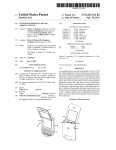
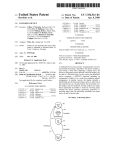
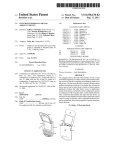
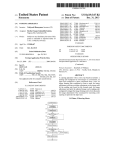
![`95385109 1%]?](http://vs1.manualzilla.com/store/data/005699459_1-7fc02fda0f8970d7c2f678aea00486d8-150x150.png)

